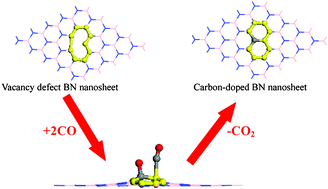Catalyst-free achieving of controllable carbon doping of boron nitridenanosheets by CO molecules: a theoretical prediction†
Abstract
Controllable carbon (C) doping in a boron nitride (BN)

* Corresponding authors
a Key Laboratory for Photonic and Electronic Bandgap Materials, Ministry of Education, Harbin Normal University, Harbin, P. R. China
Controllable carbon (C) doping in a boron nitride (BN)

 Please wait while we load your content...
Something went wrong. Try again?
Please wait while we load your content...
Something went wrong. Try again?
J. Zhao, H. Wang, Y. Liu, Q. Cai and X. Wang, RSC Adv., 2013, 3, 4917 DOI: 10.1039/C3RA22537B
To request permission to reproduce material from this article, please go to the Copyright Clearance Center request page.
If you are an author contributing to an RSC publication, you do not need to request permission provided correct acknowledgement is given.
If you are the author of this article, you do not need to request permission to reproduce figures and diagrams provided correct acknowledgement is given. If you want to reproduce the whole article in a third-party publication (excluding your thesis/dissertation for which permission is not required) please go to the Copyright Clearance Center request page.
Read more about how to correctly acknowledge RSC content.
 Fetching data from CrossRef.
Fetching data from CrossRef.
This may take some time to load.
Loading related content
